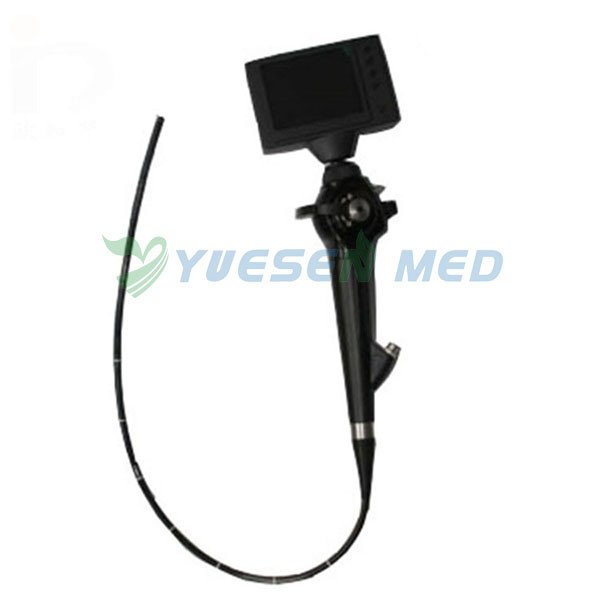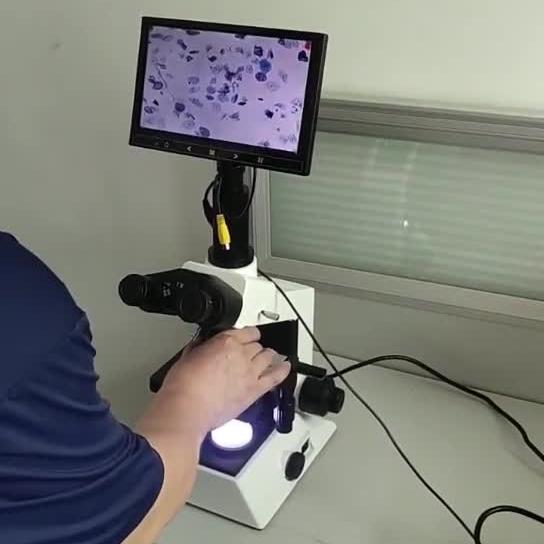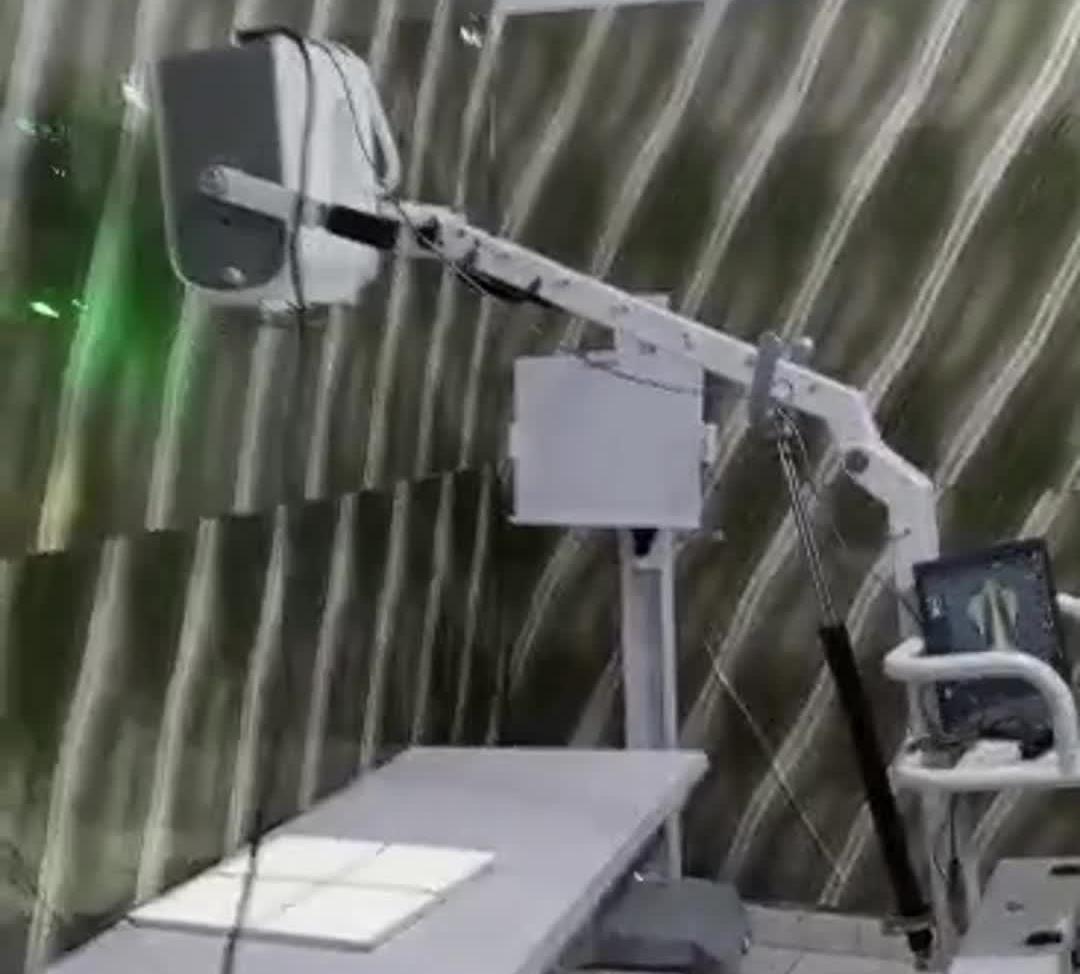Hot Products
YSX500D 50kW DR system set up and put into service in Cambodia.
YSENMED YSX500D 50kW digital x-ray system has been successfully set up and put into service in a hospital in Cambodia.
YSX056-PE serving as a vehicle-mounted x-ray in the Philippines
YSX056-PE 5.6kW portable x-ray unit has been adapted to fit on a truck, to provide mobile x-ray examination service for remote communities in the Philippines.
X Ray Machine To Zimbabwe
x ray machine, 50KW x ray machine
Microscope To Malawi
Achromatic objectives: 4X、10X、40X(S), 100X(S、Oil) Wide field eyepiece: WF10X(WF16X for option) Eyepiece head: Sliding binocular head inclined at 45° Stage: Double layer mechanical stage size 140X140mm, moving range 75X45mm Focusing: Coaxial coarse and
Exploring the Depths: A Comprehensive Guide to Portable Video Bronchoscopes
Views : 2180
Update time : 2024-03-26 14:01:00
In the realm of modern medicine, technological advancements have paved the way for innovative diagnostic and therapeutic tools. Among these groundbreaking innovations is the portable video bronchoscope, a device that has revolutionized the field of respiratory medicine. In this comprehensive guide, we'll take a deep dive into the world of portable video bronchoscopes, exploring their features, applications, benefits, and the impact they've had on patient care.

Unveiling the Portable Video Bronchoscope
Understanding the Technology
A portable video bronchoscope is a sophisticated medical instrument designed to visualize and access the airways and lungs with precision and clarity. Unlike traditional bronchoscopes, which rely on rigid tubes and external light sources, portable video bronchoscopes feature a flexible insertion tube equipped with a miniature camera and light source. This allows for real-time visualization of the respiratory system on a monitor, providing healthcare professionals with invaluable insights into the health and condition of their patients' lungs.
Components of a Portable Video Bronchoscope
Portable video bronchoscopes consist of several essential components:
1. Insertion Tube: The flexible tube that is inserted into the patient's airways. It houses the camera, light source, and channels for the insertion of additional tools.
2. Camera and Light Source: A high-definition camera and LED light source located at the tip of the insertion tube, providing clear visuals of the internal structures of the respiratory system.
3. Control Handle: The handle used by the operator to manipulate the insertion tube and control the movement of the bronchoscope within the patient's airways.
4. Monitor: A display screen where the real-time images captured by the bronchoscope are displayed, allowing healthcare professionals to observe and assess the condition of the airways and lungs.
Applications of Portable Video Bronchoscopy
Diagnostic Procedures
Portable video bronchoscopes are invaluable tools for diagnosing a wide range of respiratory conditions, including:
- Lung Cancer: By visualizing the airways and lungs, physicians can identify suspicious lesions or tumors for further evaluation and biopsy.
- Pneumonia: The bronchoscope can be used to assess the extent of inflammation and infection in the lungs, guiding treatment decisions.
- Tuberculosis: In cases of suspected tuberculosis, bronchoscopy can help confirm the diagnosis by obtaining samples for culture and microscopy.
- Chronic Obstructive Pulmonary Disease (COPD): Bronchoscopy can aid in assessing the severity of COPD and identifying potential complications such as bronchiectasis or emphysema.
Therapeutic Interventions
In addition to diagnosis, portable video bronchoscopes enable a variety of therapeutic interventions, including:
- Biopsy: Tissue samples can be obtained for histological analysis, allowing for the diagnosis of lung cancer, interstitial lung disease, or other pulmonary conditions.
- Airway Clearance: Bronchoscopy can be used to remove mucus plugs or foreign objects obstructing the airways, improving ventilation and respiratory function.
- Stent Placement: In cases of airway stenosis or obstruction, bronchoscopy-guided placement of stents can help restore airflow and alleviate symptoms.
Benefits of Portable Video Bronchoscopy
Minimally Invasive
One of the primary advantages of portable video bronchoscopy is its minimally invasive nature. Unlike traditional bronchoscopes, which may require general anesthesia and sedation, portable video bronchoscopes can often be used with local anesthesia and conscious sedation, reducing the risk of complications and enabling quicker recovery times for patients.
Real-Time Visualization
Portable video bronchoscopes provide real-time visualization of the respiratory system, allowing healthcare professionals to observe dynamic changes such as airway collapse, bleeding, or excessive secretions as they occur. This real-time feedback enhances the accuracy of diagnoses and enables prompt decision-making regarding treatment options.
Versatility and Accessibility
Unlike traditional bronchoscopes, which are often large and cumbersome, portable video bronchoscopes are compact and lightweight, making them highly versatile and accessible. They can be easily transported between different clinical settings, including hospital wards, intensive care units, and outpatient clinics, allowing for timely evaluation and treatment of patients wherever they may be.
The Future of Portable Video Bronchoscopy
As technology continues to advance, so too will the capabilities of portable video bronchoscopes. Future developments may include:
- Advanced Imaging Modalities: Integration of fluorescence or confocal microscopy could enhance diagnostic accuracy by providing detailed, high-resolution images of the respiratory system.
- Artificial Intelligence: Incorporation of artificial intelligence algorithms may enable automated detection of abnormalities, streamlining the diagnostic process and reducing the workload on healthcare professionals.
- Wireless Connectivity: Wireless bronchoscopes equipped with Bluetooth or Wi-Fi connectivity could allow for remote monitoring and consultation, facilitating collaboration between healthcare providers and improving patient care in remote or underserved areas.
Conclusion
In conclusion, portable video bronchoscopy represents a significant advancement in the field of respiratory medicine. Its ability to provide high-definition visualization of the airways and lungs, coupled with its minimally invasive nature, make it an invaluable tool for diagnosis and treatment. As technology continues to evolve, we can expect to see further improvements in portable video bronchoscopes, leading to enhanced patient care and better outcomes for individuals with respiratory conditions.
FAQs
How is a portable video bronchoscope different from a traditional bronchoscope?
A portable video bronchoscope differs from a traditional bronchoscope in several key ways. Unlike traditional bronchoscopes, which often require external light sources and rigid tubes, portable video bronchoscopes feature a built-in camera and LED light source at the tip of a flexible insertion tube. This design allows for real-time visualization of the respiratory system on a monitor, without the need for additional equipment. Additionally, portable video bronchoscopes are typically smaller and more lightweight, making them easier to maneuver and transport between different clinical settings.
Is portable video bronchoscopy painful?
Portable video bronchoscopy is generally well-tolerated by patients and is often performed with local anesthesia and conscious sedation to minimize discomfort. During the procedure, patients may experience a sensation of pressure or mild discomfort as the bronchoscope is inserted into the airways, but this is usually brief and tolerable. After the procedure, patients may experience a sore throat or cough, which typically resolves within a few days. Overall, portable video bronchoscopy is considered to be a relatively low-risk and minimally invasive procedure.
Is portable video bronchoscopy suitable for all patients?
While portable video bronchoscopy is a valuable diagnostic and therapeutic tool, it may not be suitable for all patients. Certain factors, such as the patient's overall health, medical history, and the specific indication for the procedure, may influence whether portable video bronchoscopy is appropriate. Additionally, some patients may have anatomical or physiological factors that make bronchoscopy more challenging or risky. It's essential for healthcare providers to carefully assess each patient's individual circumstances and discuss the potential risks and benefits of portable video bronchoscopy before proceeding with the procedure.

Unveiling the Portable Video Bronchoscope
Understanding the Technology
A portable video bronchoscope is a sophisticated medical instrument designed to visualize and access the airways and lungs with precision and clarity. Unlike traditional bronchoscopes, which rely on rigid tubes and external light sources, portable video bronchoscopes feature a flexible insertion tube equipped with a miniature camera and light source. This allows for real-time visualization of the respiratory system on a monitor, providing healthcare professionals with invaluable insights into the health and condition of their patients' lungs.
Components of a Portable Video Bronchoscope
Portable video bronchoscopes consist of several essential components:
1. Insertion Tube: The flexible tube that is inserted into the patient's airways. It houses the camera, light source, and channels for the insertion of additional tools.
2. Camera and Light Source: A high-definition camera and LED light source located at the tip of the insertion tube, providing clear visuals of the internal structures of the respiratory system.
3. Control Handle: The handle used by the operator to manipulate the insertion tube and control the movement of the bronchoscope within the patient's airways.
4. Monitor: A display screen where the real-time images captured by the bronchoscope are displayed, allowing healthcare professionals to observe and assess the condition of the airways and lungs.
Applications of Portable Video Bronchoscopy
Diagnostic Procedures
Portable video bronchoscopes are invaluable tools for diagnosing a wide range of respiratory conditions, including:
- Lung Cancer: By visualizing the airways and lungs, physicians can identify suspicious lesions or tumors for further evaluation and biopsy.
- Pneumonia: The bronchoscope can be used to assess the extent of inflammation and infection in the lungs, guiding treatment decisions.
- Tuberculosis: In cases of suspected tuberculosis, bronchoscopy can help confirm the diagnosis by obtaining samples for culture and microscopy.
- Chronic Obstructive Pulmonary Disease (COPD): Bronchoscopy can aid in assessing the severity of COPD and identifying potential complications such as bronchiectasis or emphysema.
Therapeutic Interventions
In addition to diagnosis, portable video bronchoscopes enable a variety of therapeutic interventions, including:
- Biopsy: Tissue samples can be obtained for histological analysis, allowing for the diagnosis of lung cancer, interstitial lung disease, or other pulmonary conditions.
- Airway Clearance: Bronchoscopy can be used to remove mucus plugs or foreign objects obstructing the airways, improving ventilation and respiratory function.
- Stent Placement: In cases of airway stenosis or obstruction, bronchoscopy-guided placement of stents can help restore airflow and alleviate symptoms.
Benefits of Portable Video Bronchoscopy
Minimally Invasive
One of the primary advantages of portable video bronchoscopy is its minimally invasive nature. Unlike traditional bronchoscopes, which may require general anesthesia and sedation, portable video bronchoscopes can often be used with local anesthesia and conscious sedation, reducing the risk of complications and enabling quicker recovery times for patients.
Real-Time Visualization
Portable video bronchoscopes provide real-time visualization of the respiratory system, allowing healthcare professionals to observe dynamic changes such as airway collapse, bleeding, or excessive secretions as they occur. This real-time feedback enhances the accuracy of diagnoses and enables prompt decision-making regarding treatment options.
Versatility and Accessibility
Unlike traditional bronchoscopes, which are often large and cumbersome, portable video bronchoscopes are compact and lightweight, making them highly versatile and accessible. They can be easily transported between different clinical settings, including hospital wards, intensive care units, and outpatient clinics, allowing for timely evaluation and treatment of patients wherever they may be.
The Future of Portable Video Bronchoscopy
As technology continues to advance, so too will the capabilities of portable video bronchoscopes. Future developments may include:
- Advanced Imaging Modalities: Integration of fluorescence or confocal microscopy could enhance diagnostic accuracy by providing detailed, high-resolution images of the respiratory system.
- Artificial Intelligence: Incorporation of artificial intelligence algorithms may enable automated detection of abnormalities, streamlining the diagnostic process and reducing the workload on healthcare professionals.
- Wireless Connectivity: Wireless bronchoscopes equipped with Bluetooth or Wi-Fi connectivity could allow for remote monitoring and consultation, facilitating collaboration between healthcare providers and improving patient care in remote or underserved areas.
Conclusion
In conclusion, portable video bronchoscopy represents a significant advancement in the field of respiratory medicine. Its ability to provide high-definition visualization of the airways and lungs, coupled with its minimally invasive nature, make it an invaluable tool for diagnosis and treatment. As technology continues to evolve, we can expect to see further improvements in portable video bronchoscopes, leading to enhanced patient care and better outcomes for individuals with respiratory conditions.
FAQs
How is a portable video bronchoscope different from a traditional bronchoscope?
A portable video bronchoscope differs from a traditional bronchoscope in several key ways. Unlike traditional bronchoscopes, which often require external light sources and rigid tubes, portable video bronchoscopes feature a built-in camera and LED light source at the tip of a flexible insertion tube. This design allows for real-time visualization of the respiratory system on a monitor, without the need for additional equipment. Additionally, portable video bronchoscopes are typically smaller and more lightweight, making them easier to maneuver and transport between different clinical settings.
Is portable video bronchoscopy painful?
Portable video bronchoscopy is generally well-tolerated by patients and is often performed with local anesthesia and conscious sedation to minimize discomfort. During the procedure, patients may experience a sensation of pressure or mild discomfort as the bronchoscope is inserted into the airways, but this is usually brief and tolerable. After the procedure, patients may experience a sore throat or cough, which typically resolves within a few days. Overall, portable video bronchoscopy is considered to be a relatively low-risk and minimally invasive procedure.
Is portable video bronchoscopy suitable for all patients?
While portable video bronchoscopy is a valuable diagnostic and therapeutic tool, it may not be suitable for all patients. Certain factors, such as the patient's overall health, medical history, and the specific indication for the procedure, may influence whether portable video bronchoscopy is appropriate. Additionally, some patients may have anatomical or physiological factors that make bronchoscopy more challenging or risky. It's essential for healthcare providers to carefully assess each patient's individual circumstances and discuss the potential risks and benefits of portable video bronchoscopy before proceeding with the procedure.
Related News
Read More >>
 Introduction video of YSENMED YSXWJ-BX301B Digital Biological Microscope.
Introduction video of YSENMED YSXWJ-BX301B Digital Biological Microscope.
Apr .01.2025
Here we share the introduction video of YSENMED YSXWJ-BX301B Digital Biological Microscope.
 YSDR-VET320 veterinary DR & YSB-DU10V color ultrasound serving well in Kiram Veterinary Surgery in Uganda
YSDR-VET320 veterinary DR & YSB-DU10V color ultrasound serving well in Kiram Veterinary Surgery in Uganda
Mar .31.2025
Kiram Veterinary Surgery in Uganda shares the clear images they have got from YSDR-VET320 veterinary digital x-ray system and YSB-DU10V vet color ultrasound machine.
 YSENMED YSFPD-R1012C mammo flat panel detector introduced and set up in a hospital in Senegal
YSENMED YSFPD-R1012C mammo flat panel detector introduced and set up in a hospital in Senegal
Mar .30.2025
Senegalese hospital has upgraded its analog mammography x-ray system with YSFPD-R1012C mammo flat panel detector, and the images come out clear.
 YSX-mDR5A 5.3kW mobile DR system working fine in a clinic in Gambia
YSX-mDR5A 5.3kW mobile DR system working fine in a clinic in Gambia
Mar .29.2025
YSENMED YSX-mDR5A 5.3kW mobile digital x-ray unit is working well in a clinic in Gambia.



